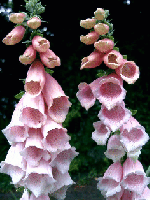 |
SCROPHULARIACEAE - The Figwort Family
This is a large plant family, with around 3000 species in around 200 genera, mainly found in the northern temperate regions of the world. Most of them are herbaceous, with a few shrubs and climbers, with one genus of trees (Paulownia). Some of them are semi-parasitic (Hay Rattle, Lousewort). Many of the plants in this Family are popular garden plants - from tiny alpines like Erinus, through Snapdragons (Antirrhinum) and Foxglove (Digitalis) to the Mulleins (Verbascum), and several are well-known weeds - the Speedwells (Veronica), Eyebright (Euphrasia) and the Toadflaxes (Linaria). Other plants in this family grown for ornament include Mimulus, Penstemon, Hebe, and Calceolaria. One or two are grown for the production of drugs, notably Digitalis (Foxglove) for digitalin. |
Characteristics of this Plant Family:
Leaves, Stem & Roots ~ Generally, the leaves are opposite or alternate, without stipules, and may be evergreen. Sometimes, they are lobed or cut.
Flowers ~ The calyx under the flowers has five lobes, and the flowers are usually borne in spikes. There are two main flower shapes. Some species (e.g. Veronica), have four petals, but many have irregular shaped flowers with five petals, often joined to form a bell or tube, sometimes with two lips. In some species (e.g. Linaria), there is a long hollow spur with honey to attract pollinators. There are two long and two short stamens attached to the petals.
Seeds ~ The seed capsule in this Family is inside the flower (superior), and has two parts, each with many small seeds.
(Click here for more information and examples of seedpods in this Family.)
Members of this Family usually have:
Opposite or alternate leaves
Flowers in spikes
Irregular flowers with four or five petals
and are mostly short herbs